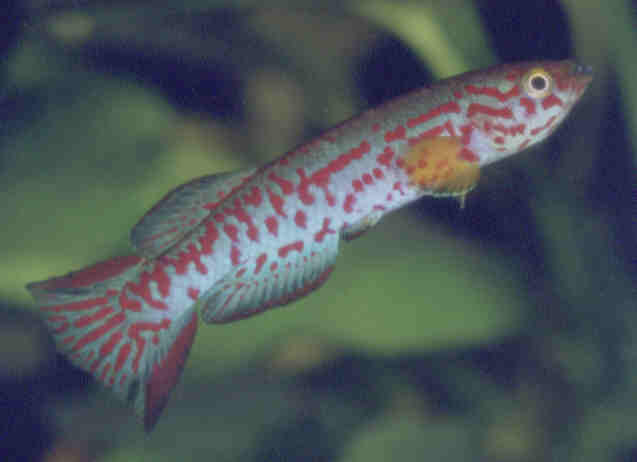Aphyosemion labarrei Poll 1951

A.labarrei. Photo courtesy of Ed Pürzl
| Meaning of Name |
After Clement Labarre the original collector. |
||||||
| First Description |
Poll M. 1951. Notes sur les Cyprinodontidae de Musée du Congo belge. Premiére partie: Les Rivulini Revue de Zoologie et de Botanique Africaines 45 (1-2): 168-170, map. |
||||||
| Size |
5.5 cmGunther |
||||||
| Meristics |
D = 12-14, A = 14-17, D/A = +5-8, ll = 30-32 (Poll 1951) |
||||||
| Karyotype |
|
||||||
| Sub-Genus |
Mesoaphyosemion |
||||||
| Group |
labarrei |
||||||
| Synonyms |
|
||||||
Populations
|
|
||||||
| Type Locality |
20 km from Madimba close to the village of Kiavo (western Zaire). Collected by Labarre 1950. |
||||||
| Distribution |
Western Zaire, in the middle to lower Insiki River drainage system including the small tributary of the Ngufu River where they were originally caught. |
||||||
| Habitat |
Swampy areas of small rainforest brooks & streams. |
||||||
| Distinguishing Characteristics | Males have very broad outer margins of red in the caudal fin. Scheel reports a 'very strong blue metallic shine on sides' in ROTOW 1. Scheel also points out a lack of yellow pigment in the species. | ||||||
| Colour/Pattern Variability | |||||||
| History |
In 1951 Poll described this species from 73 specimens collected in the Lower Congo by Labarre in 1950. The area concerned being Madimba (Inkisi) near Kiavo, Kisantu, Thysville, Kigemba near Kisantu. In 1956 Scheel received some of this species from the USA where they were being distributed as 'Blue Panchax'. Poll identified these fish as A.labarrei. Known to have been imported by the BKA August/September 1968. In 1970 Pierre Brichard exported this species to the USA. These were assigned the code NSC - 4 (New & Rare Species Committee of the AKA). In 1973 an import was received in Amsterdam. Geoff Wood collected this sp.in the early '70's to the east of Kinshasa in a forested area on the Kinshasa - Kenge road some 60 km from Kinshasa. Wood considered this sp. to be difficult to keep alive in captivity & it is doubtful if they made it to the UK. In May 2011 Armand Van Deun collected in 2 localities - Nenga Kibuku, Ngufu River & Kingembe, Inkisi River. In September 2011 Melanie Stiassny collected in the Mai Ndombe River, 100 miles from Kinshasa. |
||||||
| Breeding Notes |
Reportedly a little difficult to breed although Scheel considered them easily kept & bred. Males can be aggressive & 2-3 females would ideally be best. Eggs are large & take 12-14 days of water incubation. Growth rate is fairly rapid with sexual maturity attained at around 5 months. A breeding report appeared in BKA newsletter
No.84, August 1972. These fish were obtained in June 1970 in poor condition.
A water temperature of 75°F was used to bring the fish round which
took 2 months. For breeding this was dropped to 68°F. The fish layed
many eggs but most were infertile. Only 26 proved fertile, 16 of which
hatched out but died over a 5 day period. These fry were very weak on
hatching. Brian Moore put a breeding report in BKA newsletter
No.219, November 1983 where he bred them in rainwater. The tank was
bare except for a large floating mop. Water temperature 68-74°F.
The fish were fed lamb heart, grindal worm, fruit flies & flake. Reports have suggested that they will spawn in water of DH 15 & have been known to spawn as low as 58°F. In BKA newsletter No.329, February 1993 I wrote a piece where I reported these fish needing clean water to breed succesfully. This sp. responds well to water changes a few degrees cooler. Eggs should be kept in very clean conditions & hatch in 9 - 18 days. Growth rate was observed to be slow. Fry should be given regular water changes with well aged water. Not a long lived sp. George Molloy sent me the following
information in an e-mail 12/9/2003 where he first encountered them in
the early '70's.....(re-printed by kind permission). |
||||||
| Diameter of Egg | 1·6 - 1·8 mm. | ||||||
| Remarks |
There are a number of reports documenting how
males are aggressive towards females. Plenty of cover in the form of
plants or mops should be provided with extra females if available. |